Charming Austrian actor Willi Forst (1903-1980) personified the elegant ladykiller, dressed in tails and top hat, and was a darling of the German-speaking public. He was also one of the most significant directors, producers, and writers of the 'Wiener Filme', the light Viennese musical comedy of the 1930s and 1940s.

German postcard by Ross Verlag, no. 6069/2, 1931-1932. Photo: Atelier Binder, Berlin.

German postcard by Ross Verlag, no. 7050/1. Photo: Ufa. Willi Forst in Ein blonder Traum (Paul Martin 1932).
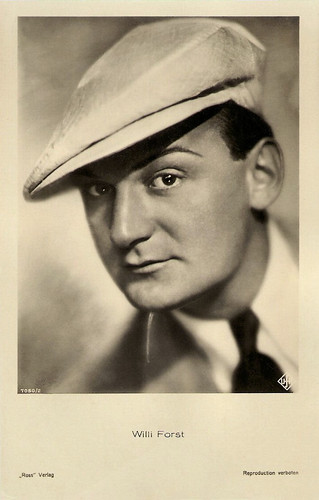
German postcard by Ross Verlag, no. 7050/2, 1932-1933. Photo: Ufa.

German postcard by Ross Verlag, no. 8085/1, 1933-1934. Photo: Willinger, Wien.
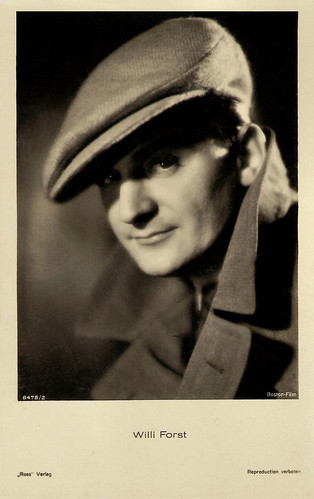
German postcard by Ross Verlag, no. 8478/2, 1933-1934. Photo: Boston-Film.

German postcard by Ross Verlag, no. A 1661/1, 1937-1938. Photo: Atelier Binder, Berlin.
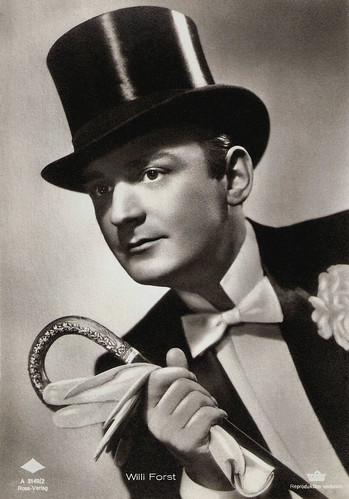
German postcard by Ross Verlag, no. A 3149/2, 1941-1944. Photo: Tobis.

German postcard. This could be a Ross Luxusklasse card (a fragment of a sticker on the back suggests this), but the edges of this card were cut off.
Willi (also written as Willy) Forst was born Wilhelm Anton Frohs in Vienna, Austria-Hungary (now Austria), in 1903. His father was the porcelain painter Wilhelm Frohs, and his mother was the miller's daughter Maria Perschl. During secondary school, he worked with some amateur theatre groups.
At age 16, he began his career as an actor. Forst got his first stage engagement in 1919 in Cieszyn, Poland, as a "second adolescent lover and comedian, with choir commitment", despite the fact that he had no actual formal training as an actor. In the following years, he acted on the provincial stages in Austria–Hungary and the German Empire and appeared as a featured performer in the post-World War I operetta theatres of Vienna and Berlin.
In 1925, he got a contract for the Berliner Metropol-Theater to appear in operettas and revues. In 1927, he returned to the prose theatre. In Berlin, he worked with the famous director Erwin Piscator at the Lessing-Theater. In 1928 an engagement to Max Reinhardt's Deutsches Theater (German Theatre).
Forst made his film debut in the Austrian film Der Wegweiser/The Signpost (Hans Kottow, 1920). He had small parts in films like Sodom und Gomorrah/Sodom and Gomorrah (Mihaly Kertész a.k.a. Michael Curtiz, 1922) starring Lucy Doraine and Strandgut/Jetsam (Hans Karl Breslauer, 1924). He played the title role in the Austrian silent film Oh, du lieber Augustin/Oh, Dear Augustine (Hans Karl Breslauer, 1922).
From 1927 he acted regularly in films. His first major screen roles were opposite Marlene Dietrich in the silent films Café Elektric/Cafe Electric (Gustav Ucicky, 1927) and Gefahren der Brautzeit/Dangers of the Engagement Period (Fred Sauer, 1929). The latter was Dietrich's final film before her breakthrough role in Der blaue Engel/The Blue Angel (Josef von Sternberg, 1930), which made her an international star and led to her departure to Hollywood.

French postcard by Europe, no. 989. Photo: Mercure Film.

French postcard by Europe, no. 990. Photo: Mercure Film.

French postcard by Europe, no. 1073. Photo: Mercure Film.

German postcard by Ross Verlag, no. 5446/2, 1930-1931. Photo: Atelier Balázs, Berlin.
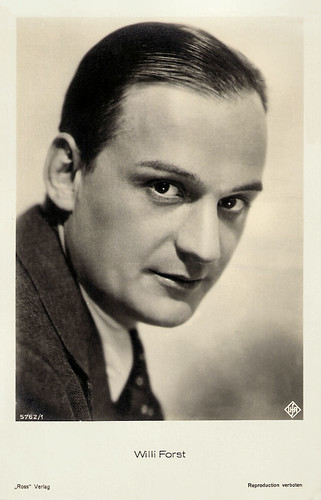
German postcard by Ross Verlag, no. 5762/1, 1930-1931. Photo: Ufa.
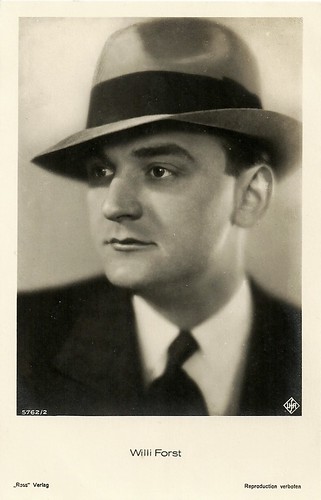
German postcard by Ross Verlag, no. 5762/2, 1930-1931. Photo: Ufa.

German postcard by Ross Verlag, no. 7050/3, 1932-1933. Photo: Ufa. Willi Forst in Ein Blonder Traum/A Blonde's Dream (Paul Martin, 1932).

German postcard by Ross Verlag, no. 8257/1, 1933-1934. Photo: Ufa / Cine-Allianz.
Willi Forst made his sound and singing film debut in Atlantik/Titanic (Ewald André Dupont, 1929). The film was the first fully talking film to be released in Germany, where it was a major hit. Forst attracted huge attention with a scene where he sat at the piano and sang a song while the ship was sinking. While singing the sad lines "Es wird ein Wein sein, und wir wer'n nimmer sein, es wird schöne Madeln geben, und wir wer'n nimmer leben...", he suddenly realizes the cruel truth of the lyrics and collapses.
Soon, he became known for his distinctive velvety voice and 'charming Viennese' characters. He became a darling of the public with a string of operetta films. After Zwei Herzen im 3/4 Takt/Two Hearts in Waltz Time (Géza von Bolváry, 1930) with music by Robert Stolz, he played six more times under the direction of Géza von Bolváry. The piece of clothing that suited him best in these films was the tailcoat – complete with cane and top hat. He moved in it as if it were his second skin.
Most of these successes were written by Austrian-born director and screenwriter Walter Reisch, who in later Hollywood exile would script Ninotchka (Ernst Lubitsch, 1939) and Gaslight (George Cukor, 1944), and work with Billy Wilder.
Reisch also wrote Ein blonder Traum/A Blonde's Dream (Paul Martin, 1932) with Lilian Harvey and Willy Fritsch, and Der Prinz von Arkadien/The Prince from Arcadien (Karl Hartl, 1932) with Liane Haid.
Forst considered the best learning experience for his future role as director, So ein Mädel vergisst man nicht/Unforgettable Girl (1933) directed by expressionist film actor-turned-director Fritz Kortner.
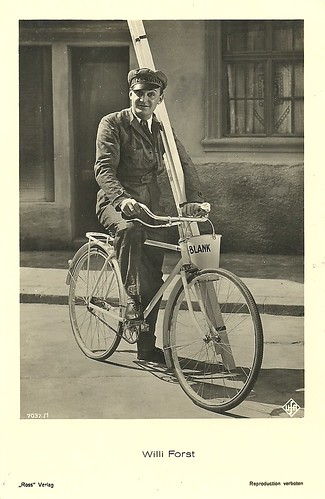
German postcard by Ross Verlag, no. 7032/1, 1932-1933. Photo: Ufa. Publicity still for Ein blonder Traum/Happy Ever After (Paul Martin, 1932).

German postcard by Ross Verlag, no. 143/4, 1931-1932. Photo: Ufa. Publicity still for Ein blonder Traum/Happy Ever After (Paul Martin, 1932).
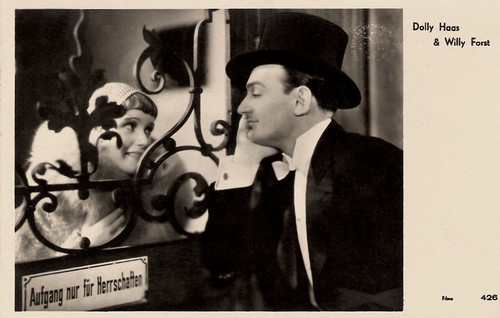
Dutch postcard by Filma, no. 426. Dolly Haas and Willi Forst in So ein Mädel vergisst man nicht/Unforgettable Girl (Fritz Kortner, 1932).
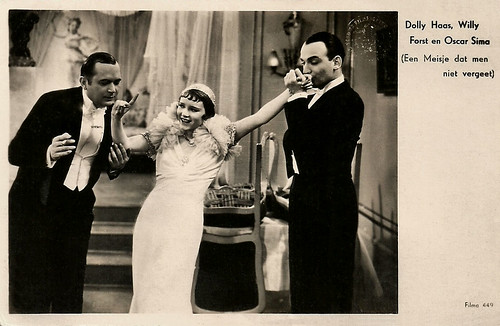
Dutch postcard by Filma, no. 449. Photo: Dolly Haas, Willi Forst and Oskar Sima in So ein Mädel vergisst man nicht/Unforgettable Girl (1932).

Latvian collector card by P. Mantnieks, Riga, for Kino Kazino. Liane Haid and Willi Forst in the Austrian-German film Der Prinz von Arkadien/The Prince of Arcadia (Karl Hartl, 1932).
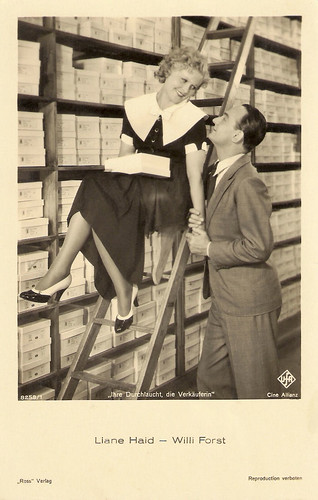
German postcard by Ross Verlag, no. 8258/1, 1933-1934. Photo: Ufa / Cine Allianz. Publicity still for the romantic comedy Ihre Durchlaucht, die Verkäuferin/Her Excellency, the Salesgirl (Karl Hartl, 1933) with Liane Haid.
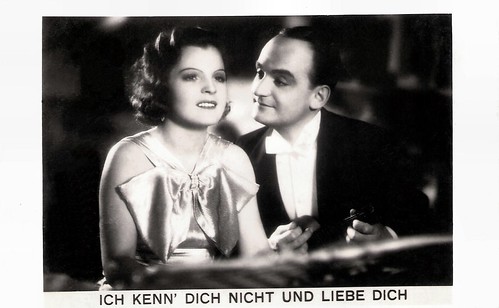
British postcard. Photo: publicity still for Ich Kenn Dich Nicht Und Liebe Dich/I Don't Know You, But I Love You (Géza von Bolváry, 1934) with Magda Schneider.

German collectors card in the series 'Vom Werden deutscher Filmkunst - Der Tonfilm', album no. 11, picture no. 36. Photo: Boston-Film / Ross Verlag. Magda Schneider and Willi Forst in Ich kenn' dich nicht und liebe dich/I Don't Know You, But I Love You (Géza von Bolváry, 1934).
Willi Forst developed the genre of the 'Wiener Filme' with writer Walter Reisch in the 1930s, beginning with the Franz Schubert melodrama Leise flehen meine Lieder/Lover Divine (Willi Forst, 1933). Leise flehen meine Lieder was so popular throughout Europe that it was reshot in a British version for the English language market as The Unfinished Symphony (1934), co-directed by Forst and Anthony Asquith.
He followed it with the hit Maskerade/Masquerade in Vienna (Willi Forst, 1934), which launched his fame as a significant director and made an instant star of Paula Wessely. For the German film Mazurka (Willi Forst, 1935), he lured Pola Negri back from Hollywood. He rapidly developed himself into a four-way talent, as a producer, director, writer and actor in German films like Allotria/Tomfoolery(Willi Forst, 1936) with Renate Müller and Serenade (Willi Forst, 1937).
Forst briefly returned to Vienna in 1936 to film Burgtheater/The Court Theatre. The film starred Werner Krauss as a great stage actor whose life is altered by one late love. As usual in the Viennese Film, the renunciation of passion and its sublimation into art provides a dramatic conclusion. From the mid-1930s he also recorded many records, largely of sentimental Viennese songs, for the Odeon Records label owned by Carl Lindström AG. He founded his own film company in 1936. The 'Willi Forst-Film-Produktion' opened a German branch in 1937 and was shut down in 1950.
Following Austria’s annexation to Germany in March 1938, Vienna’s film industry was wholly integrated into the structure and ideology of the Third Reich and given a specific cultural mission – the production of lavish musicals, costume dramas and other 'Vienna style' entertainment films for the Reich. With strong control from Berlin, the new Viennese mega-studio Wien-Film echoed the concept of the Hollywood studio system more closely than had been normal in previous Austrian cinema development.
Many Austrian talents at Ufa in Berlin, including Forst, returned home to participate in this new phase of Vienna’s industry. From 1938 until 1945 Forst was a member of the supervisory board of the Wien Film GmbH. His best-known film for Wien Film would be the elegant satire Bel Ami (Willi Forst, 1939) based on the novel by Guy de Maupassant. He also played the title role, which would be his alter ego from then on.
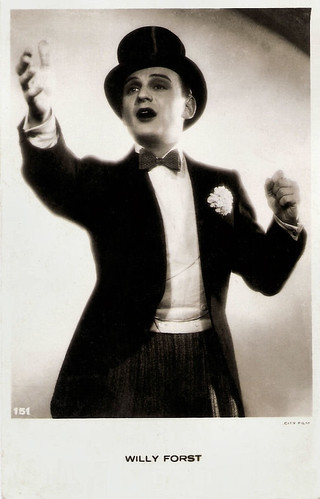
Dutch Postcard by City Film, no. 151.
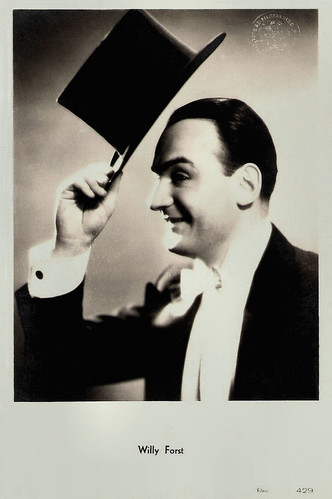
Dutch Postcard by JosPe, Arnhem, no. 429. Photo: Filma.

Dutch postcard by JosPe, Arnhem, no. 984. Photo: Remaco.
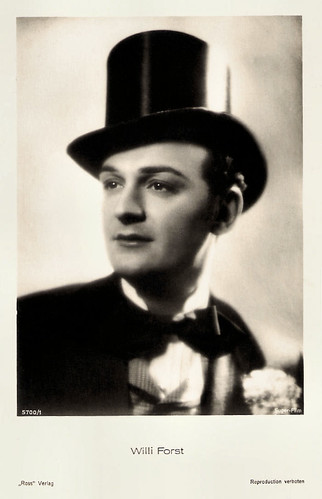
German postcard by Ross Verlag, no. 5700/1, 1930-1931. Photo: Super-Film.

German postcard by Ross Verlag, no. 7701/1, 1932-1933. Photo: Tonal - Universal. Publicity still for Brennendes Geheimnis/The Burning Secret (Robert Siodmak, 1933).

German postcard by Ross Verlag, no. 7702/1, 1932-1933. Photo: Tonal - Universal. Hilde Wagener and Willi Forst in Brennendes Geheimnis/The Burning Secret (Robert Siodmak, 1933).

German postcard by Ross Verlag, no. 8876/1, 1933-1934. Photo: Europea / Cine-Allianz. Willi Forst in So endete eine Liebe/End of an Affair (Karl Hartl, 1934).

Dutch postcard by M.B. & Z. for Rembrandt Theater, Haarlem Photo: Lumina Film. Willi Forst in So endete eine Liebe/End of an Affair (Karl Hartl, 1934).

German postcard by Ross Verlag, no. 9296/1, 1935-1936. Photo: Ufa. Willi Forst in Königswalzer/The Royal Waltz (Herbert Maisch, 1935).
Willi Forst was much courted by the Nazis. He succeeded in avoiding overt political statements, concentrating entirely on the light entertainment for which he was famous and which was much in demand during the war. During the seven years of National Socialist rule in Austria, he only made four films, none of them political. His most important work was his Wien-Film trilogy: Operette/Operetta (Willi Forst, 1940), Wiener Blut/Vienna Blood (Willi Forst, 1942) starring Willy Fritsch, and Wiener Mädeln/Vienna Beauties (Willi Forst, begun in 1944, but not completed until 1949). With box-office takings of seven million Reichsmarks, the operetta film Wiener Blut/Vienna Blood was one of the most financially successful films of the Nazi era.
Robert von Dassanowsky at Senses of Cinema: "Operette has become Forst’s best-known work. It is certainly a high point in the Viennese Film genre and brings together all of Forst’s talents as an auteur. As the film’s leading man, writer, director, and producer, also responsible for overseeing the artistic and music direction, his superbly orchestrated and uniquely detailed Romantic/decadent style can only be compared to the baroque silent films of Erich von Stroheim, to the elegant comedies of French director René Clair, and to the later operatically orchestrated style of Italian director Luchino Visconti’s nineteenth-century period films (Senso, The Leopard)."
After the war, Willi Forst emerged on the postwar film scene to reestablish Austrian film as an internationally important cinema and founded a new publication in April of 1946, Film, which was edited by Josef Malinahad. In the cinema, Forst had comparatively little success, except for the film Die Sünderin/The Sinner (Willi Forst, 1951) starring Hildegard Knef and Gustav Fröhlich. The frank treatment of social and sexual mores in Germany during and after the war and a modest nude scene of Knef created a furore at the release, but the film went on to attract an audience of seven million people.
Willi Forst's last film was the comedy Wien, du Stadt meiner Träume/Vienna, City of My Dreams (Willi Forst, 1957), with Adrian Hoven and Erika Remberg. Then he retired from the film world, acknowledging that his style was no longer in demand. After the death of his wife Melanie in 1973 he lived a reclusive life in the Swiss canton of Tessin. He died of cancer in Vienna in 1980 and is buried in Neustift am Walde.
Robert von Dassanowsky writes that Forst is "one of Austrian and Central European cinema's greatest filmmakers and influential industry figures, whose lack of presence in the international film 'canon' of important directors today is one more casualty from the negligence that has greeted Austrian cinema since the collapse of its commercial film industry in the 1960s."
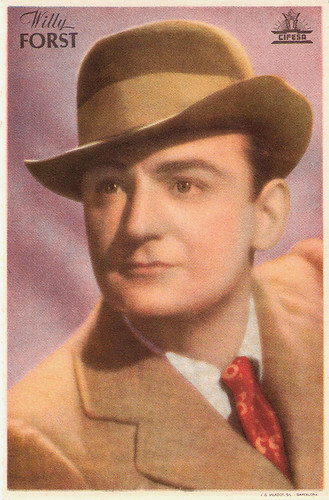
Spanish collector's card by I.G. Viladot, Barcelona. Image: Cifesa.
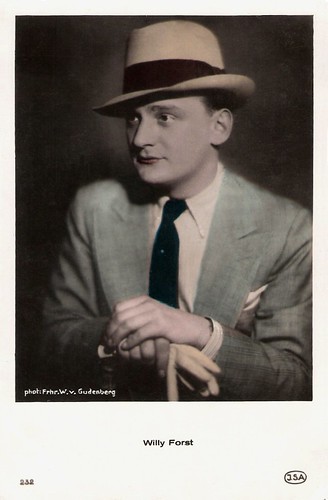
Dutch postcard by JSA, no. 232. Photo: Freiherr Wolff von Gudenberg. [Baron] Wolff von Gudenberg (1890-1961) was a noted and fashionable photographer in the 1920s and 1930s.

German postcard by Ross Verlag, no. A 1661/1, 1937-1938. Photo: Alex Binder, Berlin.

German postcard for Das Programma von Heute für Film und Theater by Ross Verlag. Photo: Lichtenstein, Berlin.

German postcard by Ross Verlag, no. 519, 1941-1944. Photo: Atelier Balázs, Berlin.

Austrian postcard by Eberle Verlag, Wien (Vienna), no. 22. Photo: I.S.B. Films.
Sources: Robert von Dassanowsky (Senses of Cinema), Thomas Staedeli (Cyranos), Filmportal.de, Wikipedia and IMDb.

German postcard by Ross Verlag, no. 6069/2, 1931-1932. Photo: Atelier Binder, Berlin.

German postcard by Ross Verlag, no. 7050/1. Photo: Ufa. Willi Forst in Ein blonder Traum (Paul Martin 1932).

German postcard by Ross Verlag, no. 7050/2, 1932-1933. Photo: Ufa.

German postcard by Ross Verlag, no. 8085/1, 1933-1934. Photo: Willinger, Wien.

German postcard by Ross Verlag, no. 8478/2, 1933-1934. Photo: Boston-Film.

German postcard by Ross Verlag, no. A 1661/1, 1937-1938. Photo: Atelier Binder, Berlin.

German postcard by Ross Verlag, no. A 3149/2, 1941-1944. Photo: Tobis.

German postcard. This could be a Ross Luxusklasse card (a fragment of a sticker on the back suggests this), but the edges of this card were cut off.
Marlene Dietrich
Willi (also written as Willy) Forst was born Wilhelm Anton Frohs in Vienna, Austria-Hungary (now Austria), in 1903. His father was the porcelain painter Wilhelm Frohs, and his mother was the miller's daughter Maria Perschl. During secondary school, he worked with some amateur theatre groups.
At age 16, he began his career as an actor. Forst got his first stage engagement in 1919 in Cieszyn, Poland, as a "second adolescent lover and comedian, with choir commitment", despite the fact that he had no actual formal training as an actor. In the following years, he acted on the provincial stages in Austria–Hungary and the German Empire and appeared as a featured performer in the post-World War I operetta theatres of Vienna and Berlin.
In 1925, he got a contract for the Berliner Metropol-Theater to appear in operettas and revues. In 1927, he returned to the prose theatre. In Berlin, he worked with the famous director Erwin Piscator at the Lessing-Theater. In 1928 an engagement to Max Reinhardt's Deutsches Theater (German Theatre).
Forst made his film debut in the Austrian film Der Wegweiser/The Signpost (Hans Kottow, 1920). He had small parts in films like Sodom und Gomorrah/Sodom and Gomorrah (Mihaly Kertész a.k.a. Michael Curtiz, 1922) starring Lucy Doraine and Strandgut/Jetsam (Hans Karl Breslauer, 1924). He played the title role in the Austrian silent film Oh, du lieber Augustin/Oh, Dear Augustine (Hans Karl Breslauer, 1922).
From 1927 he acted regularly in films. His first major screen roles were opposite Marlene Dietrich in the silent films Café Elektric/Cafe Electric (Gustav Ucicky, 1927) and Gefahren der Brautzeit/Dangers of the Engagement Period (Fred Sauer, 1929). The latter was Dietrich's final film before her breakthrough role in Der blaue Engel/The Blue Angel (Josef von Sternberg, 1930), which made her an international star and led to her departure to Hollywood.

French postcard by Europe, no. 989. Photo: Mercure Film.

French postcard by Europe, no. 990. Photo: Mercure Film.

French postcard by Europe, no. 1073. Photo: Mercure Film.

German postcard by Ross Verlag, no. 5446/2, 1930-1931. Photo: Atelier Balázs, Berlin.

German postcard by Ross Verlag, no. 5762/1, 1930-1931. Photo: Ufa.

German postcard by Ross Verlag, no. 5762/2, 1930-1931. Photo: Ufa.

German postcard by Ross Verlag, no. 7050/3, 1932-1933. Photo: Ufa. Willi Forst in Ein Blonder Traum/A Blonde's Dream (Paul Martin, 1932).

German postcard by Ross Verlag, no. 8257/1, 1933-1934. Photo: Ufa / Cine-Allianz.
Velvety voice
Willi Forst made his sound and singing film debut in Atlantik/Titanic (Ewald André Dupont, 1929). The film was the first fully talking film to be released in Germany, where it was a major hit. Forst attracted huge attention with a scene where he sat at the piano and sang a song while the ship was sinking. While singing the sad lines "Es wird ein Wein sein, und wir wer'n nimmer sein, es wird schöne Madeln geben, und wir wer'n nimmer leben...", he suddenly realizes the cruel truth of the lyrics and collapses.
Soon, he became known for his distinctive velvety voice and 'charming Viennese' characters. He became a darling of the public with a string of operetta films. After Zwei Herzen im 3/4 Takt/Two Hearts in Waltz Time (Géza von Bolváry, 1930) with music by Robert Stolz, he played six more times under the direction of Géza von Bolváry. The piece of clothing that suited him best in these films was the tailcoat – complete with cane and top hat. He moved in it as if it were his second skin.
Most of these successes were written by Austrian-born director and screenwriter Walter Reisch, who in later Hollywood exile would script Ninotchka (Ernst Lubitsch, 1939) and Gaslight (George Cukor, 1944), and work with Billy Wilder.
Reisch also wrote Ein blonder Traum/A Blonde's Dream (Paul Martin, 1932) with Lilian Harvey and Willy Fritsch, and Der Prinz von Arkadien/The Prince from Arcadien (Karl Hartl, 1932) with Liane Haid.
Forst considered the best learning experience for his future role as director, So ein Mädel vergisst man nicht/Unforgettable Girl (1933) directed by expressionist film actor-turned-director Fritz Kortner.

German postcard by Ross Verlag, no. 7032/1, 1932-1933. Photo: Ufa. Publicity still for Ein blonder Traum/Happy Ever After (Paul Martin, 1932).

German postcard by Ross Verlag, no. 143/4, 1931-1932. Photo: Ufa. Publicity still for Ein blonder Traum/Happy Ever After (Paul Martin, 1932).

Dutch postcard by Filma, no. 426. Dolly Haas and Willi Forst in So ein Mädel vergisst man nicht/Unforgettable Girl (Fritz Kortner, 1932).

Dutch postcard by Filma, no. 449. Photo: Dolly Haas, Willi Forst and Oskar Sima in So ein Mädel vergisst man nicht/Unforgettable Girl (1932).

Latvian collector card by P. Mantnieks, Riga, for Kino Kazino. Liane Haid and Willi Forst in the Austrian-German film Der Prinz von Arkadien/The Prince of Arcadia (Karl Hartl, 1932).

German postcard by Ross Verlag, no. 8258/1, 1933-1934. Photo: Ufa / Cine Allianz. Publicity still for the romantic comedy Ihre Durchlaucht, die Verkäuferin/Her Excellency, the Salesgirl (Karl Hartl, 1933) with Liane Haid.

British postcard. Photo: publicity still for Ich Kenn Dich Nicht Und Liebe Dich/I Don't Know You, But I Love You (Géza von Bolváry, 1934) with Magda Schneider.

German collectors card in the series 'Vom Werden deutscher Filmkunst - Der Tonfilm', album no. 11, picture no. 36. Photo: Boston-Film / Ross Verlag. Magda Schneider and Willi Forst in Ich kenn' dich nicht und liebe dich/I Don't Know You, But I Love You (Géza von Bolváry, 1934).
Bel Ami
Willi Forst developed the genre of the 'Wiener Filme' with writer Walter Reisch in the 1930s, beginning with the Franz Schubert melodrama Leise flehen meine Lieder/Lover Divine (Willi Forst, 1933). Leise flehen meine Lieder was so popular throughout Europe that it was reshot in a British version for the English language market as The Unfinished Symphony (1934), co-directed by Forst and Anthony Asquith.
He followed it with the hit Maskerade/Masquerade in Vienna (Willi Forst, 1934), which launched his fame as a significant director and made an instant star of Paula Wessely. For the German film Mazurka (Willi Forst, 1935), he lured Pola Negri back from Hollywood. He rapidly developed himself into a four-way talent, as a producer, director, writer and actor in German films like Allotria/Tomfoolery(Willi Forst, 1936) with Renate Müller and Serenade (Willi Forst, 1937).
Forst briefly returned to Vienna in 1936 to film Burgtheater/The Court Theatre. The film starred Werner Krauss as a great stage actor whose life is altered by one late love. As usual in the Viennese Film, the renunciation of passion and its sublimation into art provides a dramatic conclusion. From the mid-1930s he also recorded many records, largely of sentimental Viennese songs, for the Odeon Records label owned by Carl Lindström AG. He founded his own film company in 1936. The 'Willi Forst-Film-Produktion' opened a German branch in 1937 and was shut down in 1950.
Following Austria’s annexation to Germany in March 1938, Vienna’s film industry was wholly integrated into the structure and ideology of the Third Reich and given a specific cultural mission – the production of lavish musicals, costume dramas and other 'Vienna style' entertainment films for the Reich. With strong control from Berlin, the new Viennese mega-studio Wien-Film echoed the concept of the Hollywood studio system more closely than had been normal in previous Austrian cinema development.
Many Austrian talents at Ufa in Berlin, including Forst, returned home to participate in this new phase of Vienna’s industry. From 1938 until 1945 Forst was a member of the supervisory board of the Wien Film GmbH. His best-known film for Wien Film would be the elegant satire Bel Ami (Willi Forst, 1939) based on the novel by Guy de Maupassant. He also played the title role, which would be his alter ego from then on.

Dutch Postcard by City Film, no. 151.

Dutch Postcard by JosPe, Arnhem, no. 429. Photo: Filma.

Dutch postcard by JosPe, Arnhem, no. 984. Photo: Remaco.

German postcard by Ross Verlag, no. 5700/1, 1930-1931. Photo: Super-Film.

German postcard by Ross Verlag, no. 7701/1, 1932-1933. Photo: Tonal - Universal. Publicity still for Brennendes Geheimnis/The Burning Secret (Robert Siodmak, 1933).

German postcard by Ross Verlag, no. 7702/1, 1932-1933. Photo: Tonal - Universal. Hilde Wagener and Willi Forst in Brennendes Geheimnis/The Burning Secret (Robert Siodmak, 1933).

German postcard by Ross Verlag, no. 8876/1, 1933-1934. Photo: Europea / Cine-Allianz. Willi Forst in So endete eine Liebe/End of an Affair (Karl Hartl, 1934).

Dutch postcard by M.B. & Z. for Rembrandt Theater, Haarlem Photo: Lumina Film. Willi Forst in So endete eine Liebe/End of an Affair (Karl Hartl, 1934).

German postcard by Ross Verlag, no. 9296/1, 1935-1936. Photo: Ufa. Willi Forst in Königswalzer/The Royal Waltz (Herbert Maisch, 1935).
Wiener Filme
Willi Forst was much courted by the Nazis. He succeeded in avoiding overt political statements, concentrating entirely on the light entertainment for which he was famous and which was much in demand during the war. During the seven years of National Socialist rule in Austria, he only made four films, none of them political. His most important work was his Wien-Film trilogy: Operette/Operetta (Willi Forst, 1940), Wiener Blut/Vienna Blood (Willi Forst, 1942) starring Willy Fritsch, and Wiener Mädeln/Vienna Beauties (Willi Forst, begun in 1944, but not completed until 1949). With box-office takings of seven million Reichsmarks, the operetta film Wiener Blut/Vienna Blood was one of the most financially successful films of the Nazi era.
Robert von Dassanowsky at Senses of Cinema: "Operette has become Forst’s best-known work. It is certainly a high point in the Viennese Film genre and brings together all of Forst’s talents as an auteur. As the film’s leading man, writer, director, and producer, also responsible for overseeing the artistic and music direction, his superbly orchestrated and uniquely detailed Romantic/decadent style can only be compared to the baroque silent films of Erich von Stroheim, to the elegant comedies of French director René Clair, and to the later operatically orchestrated style of Italian director Luchino Visconti’s nineteenth-century period films (Senso, The Leopard)."
After the war, Willi Forst emerged on the postwar film scene to reestablish Austrian film as an internationally important cinema and founded a new publication in April of 1946, Film, which was edited by Josef Malinahad. In the cinema, Forst had comparatively little success, except for the film Die Sünderin/The Sinner (Willi Forst, 1951) starring Hildegard Knef and Gustav Fröhlich. The frank treatment of social and sexual mores in Germany during and after the war and a modest nude scene of Knef created a furore at the release, but the film went on to attract an audience of seven million people.
Willi Forst's last film was the comedy Wien, du Stadt meiner Träume/Vienna, City of My Dreams (Willi Forst, 1957), with Adrian Hoven and Erika Remberg. Then he retired from the film world, acknowledging that his style was no longer in demand. After the death of his wife Melanie in 1973 he lived a reclusive life in the Swiss canton of Tessin. He died of cancer in Vienna in 1980 and is buried in Neustift am Walde.
Robert von Dassanowsky writes that Forst is "one of Austrian and Central European cinema's greatest filmmakers and influential industry figures, whose lack of presence in the international film 'canon' of important directors today is one more casualty from the negligence that has greeted Austrian cinema since the collapse of its commercial film industry in the 1960s."

Spanish collector's card by I.G. Viladot, Barcelona. Image: Cifesa.

Dutch postcard by JSA, no. 232. Photo: Freiherr Wolff von Gudenberg. [Baron] Wolff von Gudenberg (1890-1961) was a noted and fashionable photographer in the 1920s and 1930s.

German postcard by Ross Verlag, no. A 1661/1, 1937-1938. Photo: Alex Binder, Berlin.

German postcard for Das Programma von Heute für Film und Theater by Ross Verlag. Photo: Lichtenstein, Berlin.

German postcard by Ross Verlag, no. 519, 1941-1944. Photo: Atelier Balázs, Berlin.

Austrian postcard by Eberle Verlag, Wien (Vienna), no. 22. Photo: I.S.B. Films.
Sources: Robert von Dassanowsky (Senses of Cinema), Thomas Staedeli (Cyranos), Filmportal.de, Wikipedia and IMDb.
No comments:
Post a Comment